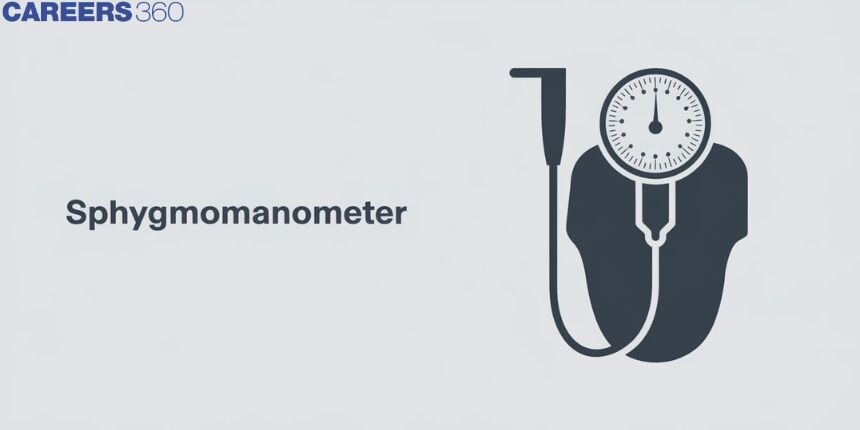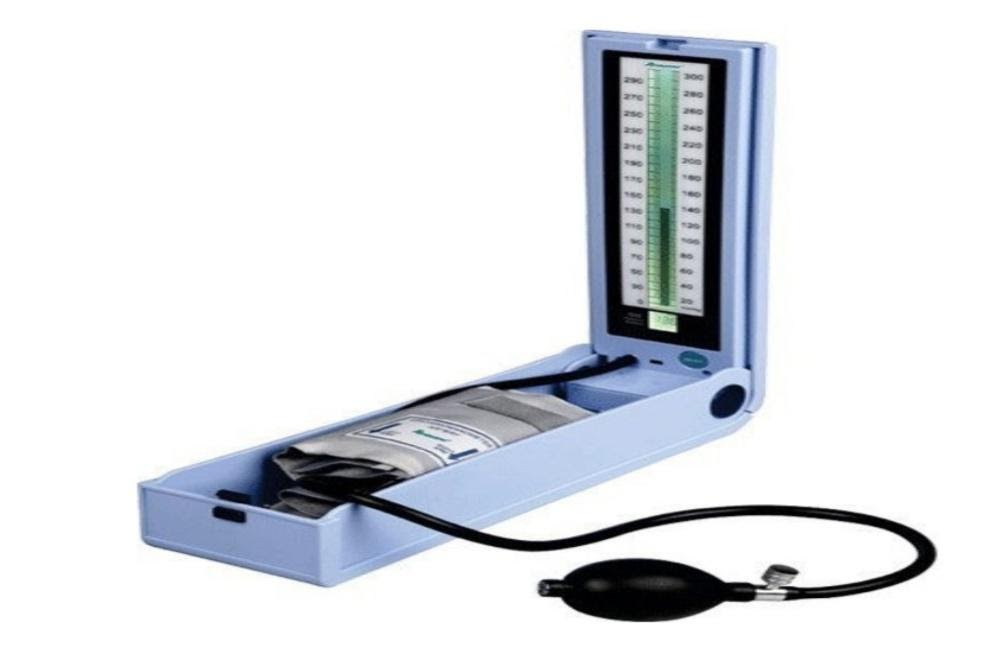Sphygmomanometer - Types, Parts, How To Use, FAQs
Introduction
The force applied by the blood on the wall of the blood vessels is named as the blood pressure. Sphygmomanometer is used to measure blood pressure. In this article we will learn in detail about the sphygmomanometer, sphygmomanometer parts (also bp apparatus parts) sphygmomanometer uses and sphygmomanometer types: mercury sphygmomanometer, aneroid sphygmomanometer and digital sphygmomanometer.
JEE Main/NEET 2027: Physics Important Formulas for Class 10
NEET 2025: Mock Test Series | Syllabus | High Scoring Topics | PYQs
JEE Main: Study Materials | High Scoring Topics | Preparation Guide
JEE Main: Syllabus | Sample Papers | Mock Tests | PYQs
- Introduction
- What is a sphygmomanometer?
- Types of sphygmomanometer:
- How to check blood pressure using sphygmomanometer?

What do we know about blood pressure?
The pressure is higher in arteries than the veins. High blood pressure is also called hypertension. All blood applies a thrust on the muscular walls of the blood vessels. That thrust is said to be as blood pressure and it increases and decreases with the beating of the heart. It's highest during systole, when the heartbeat contracts to force blood through the arteries. This is your systolic blood pressure. When the heart is at relaxation in the middle of beats blood pressure drops to its lowest value, the diastolic pressure. A typical healthy individual produces a systolic pressure between 90 and 120 mm of mercury and diastolic pressure between 60 and 80 mm of mercury. Taking together a normal reading is a bit less than 120 over 80. The blood traverses the landscapes of the body through the pipes of the circulatory system. In any plumbing system several things can Increase the force on the wall of the pipes: The properties of the fluid, extra fluid or narrower pipes. So if the blood coagulates a higher pressure is required to push it therefore the heart will pump harder. A high salt intake will lead to alike result. The salt promotes water retention and the extra fluid increases the blood volume and blood pressure and stress like the fight or flight response releases hormones like epinephrine or norepinephrine that compress key vessels, increasing the struggle to flow and raising the pressure upstream. Blood vessels can generally lever these fluctuations with ease. Elastic fibres embedded in their walls make them resilient but if your blood pressure regularly rises above about 140 over 90 what we call hypertension and stays there. It can cause serious problems.
Also check-
- NCERT Exemplar Class 11th Physics Solutions
- NCERT Exemplar Class 12th Physics Solutions
- NCERT Exemplar Solutions for All Subjects
What is a sphygmomanometer?
Sphygmomanometer measures the blood pressure of a person. Who invented sphygmomanometer? Sphygmomanometer invented by Von Basch. It is a instrument that is in every household nowadays. Sphygmomanometer cost is between 1000 to 2000 rupees. Sphygmomanometer in Hindi is रक्तदाबमापी
Now let us answer to the question what are sphygmomanometer parts name? How to measure blood pressure with sphygmomanometer? How to use sphygmomanometer?
Types of sphygmomanometer:
There are three types of sphygmomanometer: mercury sphygmomanometer, aneroid sphygmomanometer and digital sphygmomanometer.
Mercury sphygmomanometer: This is utmost conformist type of blood pressure tool and is well-thought-out to be the golden standard. This apparatus contain manually inflated cuffs which are connected to the mercury infused tunes for attaining the accurate measurement or readings. The apparatus must be kept on a plane surface and in vertical position. In case if the apparatus is dropped accidentally then there are enhanced possibilities of risks.

Mercury bp apparatus price in India is between 1000 to 2000 rupees. Advantages: last for life time, easy to use and no need of recalibration. Disadvantages: because of its toxic content it is banned in some nations.
Aneroid sphygmomanometer:

Aneroid sphygmomanometer meaning is without fluid. Mercury is not used in this type of sphygmomanometer. This contain a stethoscope that is connected to the cuff which is further connected to a dial gauge with tubing. To cover the cuff pressure to gauge pressure the gauge head have a mechanical portion. This apparatus required to be recalibrated to avoid false readings. There are other various kinds of aneroid sphygmomanometer based on their usage.
Digital sphygmomanometer:
This is the most technologically advanced sphygmomanometer. This contain an electronic sensor to measure the blood pressure and the measurement are shown on the digital monitor.

To measure the blood pressure the apparatus measure the fluctuations of arteries. These require to be checked using mercury sphygmomanometer to avoid inaccurate readings.
Related Topics Link, |
Parts of sphygmomanometer
An inflated flat rubber bag covered by a non distensible cloth envelope. The cavity of the bag is connected by a long rubber tube to a Manometer and by a short tube to a rubber pump. By this way the bag can be overblown to any anticipated pressure. A small valve is provided between the pump and the bag which permits the escape of air and reduction of the pressure as required to compensate tissue resistance. The Manometer is a U shaped tube, one limb being extensive than another. The broader limb is the reservoir for mercury and the narrow limb is graduated from 0 to 300 mm with the smallest division corresponding to a reading of 2mm hg. The inflated bag dimensions for adults are 23*12.5 cm, width of these bag varies with the age of the individual: below 1 year- 2.5 cm, below 4 years- 5 cm, below 8 years- 8 cm and for adults- 12.5 cm. Sphygmomanometer working principle: It involves the balancing of pressure in a bag that is air pressure against the pressure of the blood in an artery. This air pressure is estimated by means of mercury or air Manometer.
Also Read:
- NCERT solutions for Class 11 Physics Chapter 10 Mechanical Properties of Fluids
- NCERT Exemplar Class 11 Physics Solutions Chapter 10 Mechanical Properties of Fluids
- NCERT notes Class 11 Physics Chapter 10 Mechanical Properties of Fluids
How to check blood pressure using sphygmomanometer?
Two methods are commonly in use for the measurement of systematic arterial BP:
Palpatory method :
Allow the person to sit at ease in a chair or to lie horizontal on the check-up couch for 5 minutes. The uninflated cuff of sphygmomanometer is wrapped firmly around the bare upper arm 2.5-3 cm above elbow joint at the heart level. Feel for the radial pulse ND inflate the rubber bag to increase the pressure 20-30 mm Hg above the points at which the radial pulse will disappear at the wrist. Now deflate the cuff slowly releasing the pressure at the rate of 2-3 mm Hg/sec. While lowering the pressure keep palpating the radial artery and reading is taken just when pulse start reappearing. This gives the systolic BP. Disadvantages of this method are that diastolic BP cannot be estimated and systolic BP estimated is lower than the actual by 6-10 mm hg.
Auscultatory method:
Allow the person to sit at ease in a chair or to lie horizontal on the check-up couch for 5 minutes. The uninflated cuff of sphygmomanometer is wrapped firmly around the upper area 2.5-3 cm above the elbow joint at the heart level. Place the chart piece on stethoscope over the arm medial to the tendon of biceps where the pulsations of brachial artery are felt. Under ordinary circumstances if a stethoscope is placed over an artery no sound can be heard, as the stream line flow of blood through the unconstructed blood vessels produces no sound. Inflate the cuff rapidly until the pressure in it is well above the systolic BP as measured by the palpatory method. The brachial artery gets occluded by the cuff and no sound can be heard with the stethoscope. Now gradually lower the cuff pressure by opening the valve till a clear sharp tapping sound is heard. The cuff pressure at which the sound is heard first, gives a measure of systolic BP. The pressure in the cuff is further progressively lowered while listening for the appearance of the sound of Korotkoff's. The sound undergoes a series of changes in quality and becomes dull and muffled to disappear finally. The cuffs pressure at which the sound becomes muffled or disappears is the diastolic BP.
Also read -
- NCERT Solutions for Class 11 Physics
- NCERT Solutions for Class 12 Physics
- NCERT Solutions for All Subjects
NCERT Physics Notes:
Frequently Asked Questions (FAQs)
Bp instruments part name are: pressure cuff, bulb, pressure control valve and a tube.
Sphygmomanometer was discovered by Von Basch.
Cuff should be placed at the level of the heart while taking readings.
There are two methods:Palpatory method and Auscultatory method.
Mercury sphygmomanometer, Aneroid sphygmomanometer and Digital sphygmomanometer.
Also Read
24 Dec'24 05:57 PM
16 Nov'24 11:39 AM
12 Nov'24 11:51 PM
12 Nov'24 09:36 PM
12 Nov'24 09:16 PM
11 Nov'24 07:25 PM
11 Nov'24 06:00 PM
05 Nov'24 07:02 AM
26 Sep'24 11:28 AM


